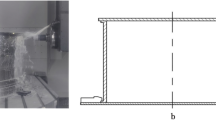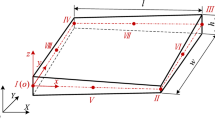Abstract
Because of its poor rigidity, a thin-walled casing can easily cause chatter during the cutting process, which seriously affects the efficient processing of the casing, so some measures are needed to suppress the flutter. In this paper, a dynamic model of flexible fixtures for thin-walled casings is presented. This model differs from the analysis of casings with rigid fixtures. A new flexible fixture has been designed based on the principle of multiple dynamic vibration absorbers. A hybrid dynamic model of the lumped mass method and the finite element method for thin-walled casings and flexible fixtures has been developed, and the effect of flexible fixtures on the vibration suppression of thin-walled casings is analyzed. To verify the model, a typical thin-walled casing is taken as an example, and the accuracy of the dynamic model is verified by the comparison between the modal test results and the simulation results. The simulation and experimental results show that the model can effectively reflect the dynamic response of thin-walled casings under the flexible fixture. With a flexible fixture, the corresponding amplitude of the frequency response of the casing is reduced, and the frequency is shifted to the right. Through cutting experiments, it is found that the low-order vibration amplitude of the system is reduced by nearly 20 times and the coupling vibration amplitude of the cutter and the workpiece is reduced by nearly 5 times with a flexible fixture. Finally, it is also noted that flexible fixtures are an effective measure to suppress casing flutter.











Similar content being viewed by others
References
Aoyama T, Kakinuma Y (2005) Development of fixture devices for thin and compliant workpieces. Cirp Ann-Manuf Technol 54(1):325–328
Rai JK, Xirouchakis P (2008) Finite element method based machining simulation environment for analyzing part errors induced during milling of thin-walled components. Int J Mach Tool Manu 48(6):629–643
Gao YY, Ma JW, Jia ZY, Wang FJ, Si LK, Song DN (2016) Tool path planning and machining deformation compensation in high-speed milling for difficult-to-machine material thin-walled parts with curved surface. Int J Adv Manuf Technol 84(9–12):1757–1767
Rashid A, Nicolescu CM (2008) Design and implementation of tuned viscoelastic dampers for vibration control in milling. Int J Mach Tool Manu 48(9):1036–1053
Kolluru K, Axinte D, Becker A (2013) A solution for minimising vibrations in milling of thin walled casings by applying dampers to workpiece surface. Cirp Ann-Manuf Technol 62(1):415–418
Zhang H-T, Chen Z, Chen P, Zhang X-M, Ding H (2016a) Saturated output regulation approach for active vibration control of thin-walled flexible workpieces with voice coil actuators. IEEE/ASME Trans Mechatron 21:266–275
Parus A, Powałka B, Marchelek K, Domek S, Hoffmann MJJOV, Control (2013) Active vibration control in milling flexible workpieces. J Vib Control 19(7):1103–1120
Liu Y, Wu B, Ma J, Zhang D (2017) Chatter identification of the milling process considering dynamics of the thin-walled workpiece. Int J Adv Manuf Technol 89(5):1765–1773
Zhang X, Yu T, Wang W, Ehmann KF (2016b) Three-dimensional process stability prediction of thin-walled workpiece in milling operation. Mach Sci Technol 20(3):406–424
Li ZY, Sun YW, Guo DM (2017) Chatter prediction utilizing stability lobes with process damping in finish milling of titanium alloy thin-walled workpiece. Int J Adv Manuf Technol 89(9–12):2663–2674
Tuysuz O, Altintas Y (2018) Time-domain modeling of varying dynamic characteristics in thin-wall machining using perturbation and reduced-order substructuring methods. J Manuf Sci Eng-Trans ASME 140(1)
Zeng SS, Wan XJ, Li WL, Yin ZP, Xiong YL (2012) A novel approach to fixture design on suppressing machining vibration of flexible workpiece. Int J Mach Tool Manu 58(7):29–43
Ma JJ, Zhang DH, Wu BH, Luo M, Liu YL (2017) Stability improvement and vibration suppression of the thin-walled workpiece in milling process via magnetorheological fluid flexible fixture. Int J Adv Manuf Technol 88(5–8):1231–1242
Acknowledgments
We also thank all reviewers and editors for their valuable comments and suggestions.
Funding
This study was financially supported by the Key Project of Deformation Control Technology for 123 Case in Aviation Industry (nos. GTX20160029) and Major National Science and Technology Projects for High-grade CNC Machine Tools and Basic Manufacturing Equipment (nos. 2014ZX04001021 and 2018ZX04003001) of China.
Author information
Authors and Affiliations
Corresponding author
Additional information
Publisher’s note
Springer Nature remains neutral with regard to jurisdictional claims in published maps and institutional affiliations.
Rights and permissions
About this article
Cite this article
Wang, X., Ma, P., Peng, X. et al. Study on vibration suppression performance of a flexible fixture for a thin-walled casing. Int J Adv Manuf Technol 106, 4281–4291 (2020). https://doi.org/10.1007/s00170-019-04696-w
Received:
Accepted:
Published:
Issue Date:
DOI: https://doi.org/10.1007/s00170-019-04696-w




